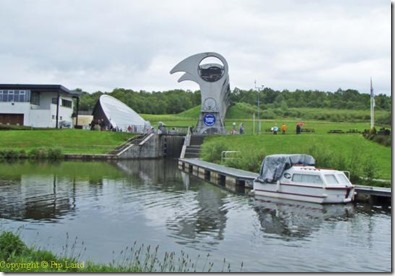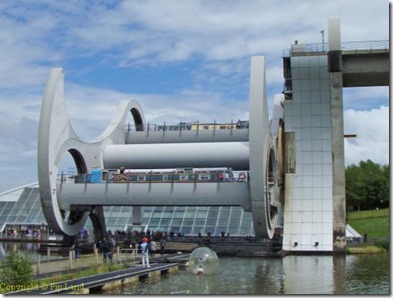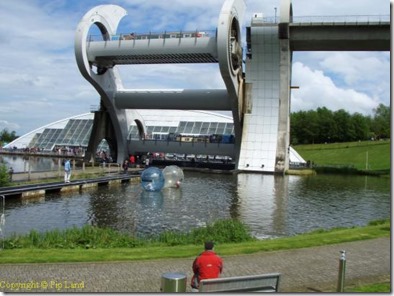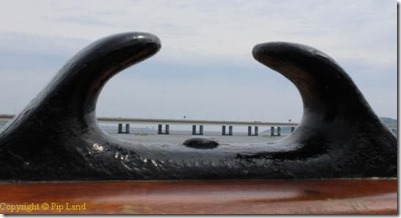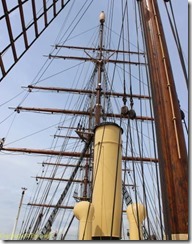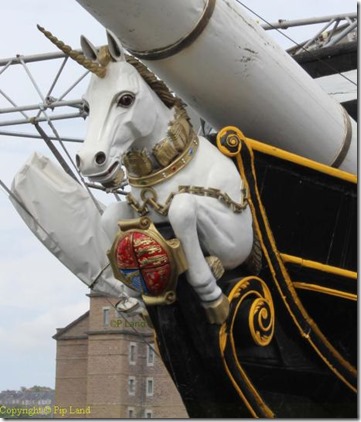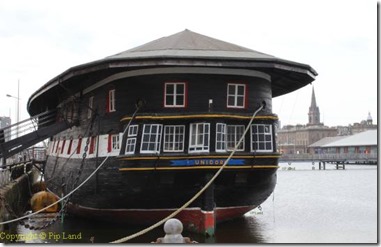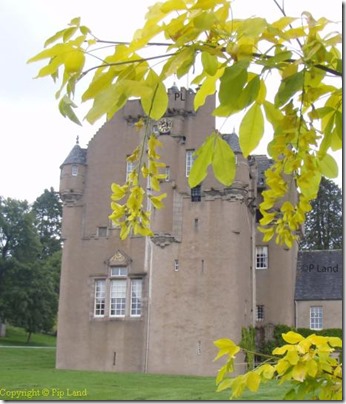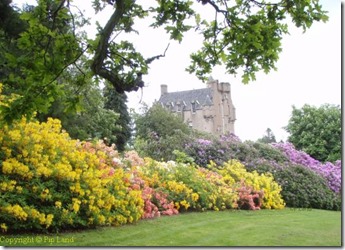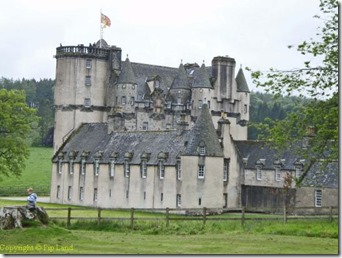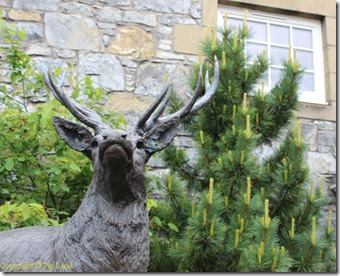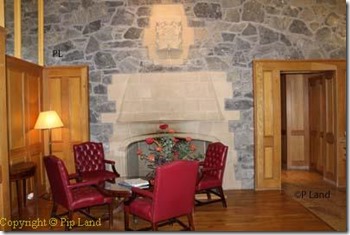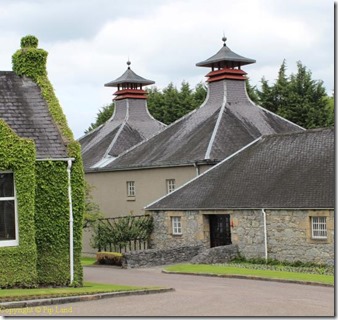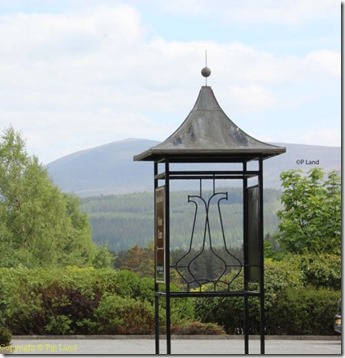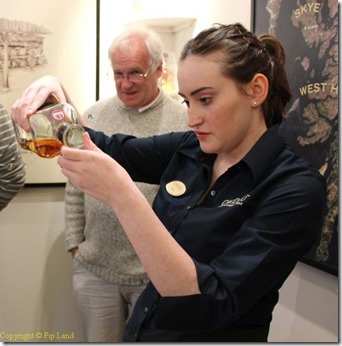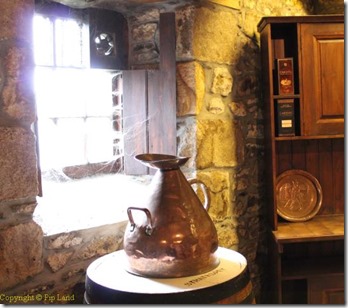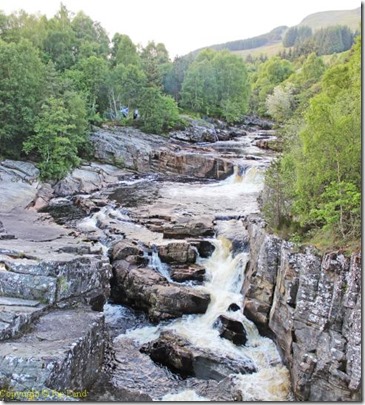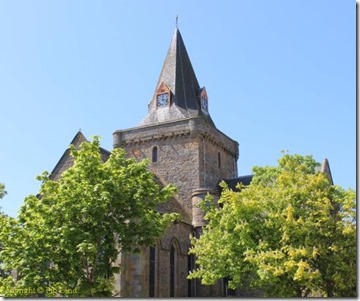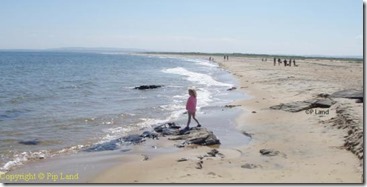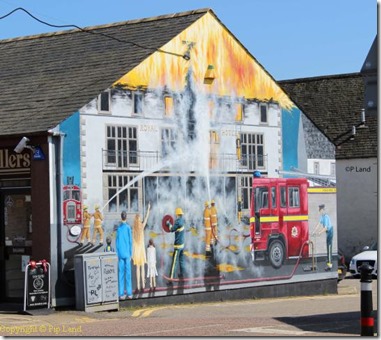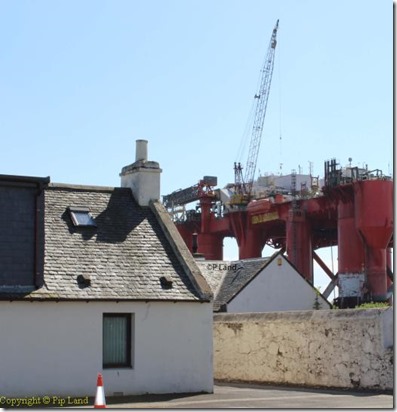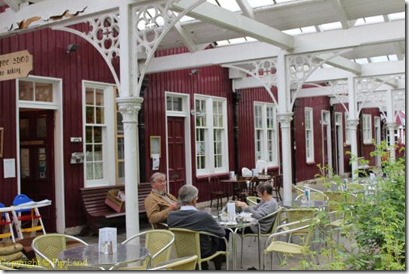On Monday, May 26 David and I set out on a journey to Scotland. In the next …. days we visited the Falkirk Wheel, the RSS Discovery and the HMS Unicorn in Dundee, Crathes Castle and Castle Fraser in the Dee Valley, the Speyside distilleries – Glenfiddich and Cardhu, and Dornoch, Strathpeffer and Invergordon. Along the way we stayed at Premier Inns at Stirling and Aberdeen.
Day One:
The morning we set off for Scotland was one of those days when I wondered why we were leaving Wensleydale. Scudding clouds and bright sunshine are my favourite weather conditions in the Yorkshire Dales for it is then that the hills and valleys seem to change endlessly. Field patterns are highlighted and then pushed into a shadowy background while the scars shine and dominate.
David chose a route which meant we could enjoy that scenery for as long as possible. We went via Hawes to the Moorcroft and then north to Brough. I quite happily enjoyed the wonderful views from the A66 across the northern part of the Yorkshire Dales and onto the Lake District while David drove.
The sunshine had disappeared, however, by the time we reached the Scottish Lowlands and we wondered if the rain would lift before we reached our first destination: the Falkirk Wheel. It did thankfully and as we walked from the car park to the Forth and Clyde canal we got our first view of this majestic and truly awesome piece of modern engineering (below).
This unique boatlift connects the Union Canal to the Forth and Clyde 25 metres below. It was completed in 2002 as part of the 114km long canal restoration scheme called The Millennium Link. Equally amazing was the multi-cultural nature of the large crowd there on Bank Holiday Monday.
The restaurant at the visitor centre coped well, even with my request for milk and tomato free food during a very busy lunch time.Then, as the rain had stopped, we walked round the holding basin to where we could watch the wheel at work – and those see almost all the other attractions which included a great place for children and adults to experiment with ways of moving water in the Water Play Park. Those participating in the waterwalking experience didn’t get as wet! Below: boats being moved from one canal to another; and watching children enjoying “waterwalking”.
It was then time to find the Premier Inn at the Whins of Milton on the Glasgow Road towards Stirling. Later we saw more places described as Milton and I finally found out that this meant a hamlet which had grown up around a Mill. Whin is common gorse or furze.
The room was as good as ever and we certainly appreciated having a large TV screen in place of the latest “blobby” pictures that have become a feature of Premier Inns these days. We certainly wouldn’t describe those pictures as artistic.
As I fancied a pizza we went and found the Pizza Hut at Stirling – where the manager went over and above the call of duty to ensure that I had an excellent milk-free pizza base moistened with virgin oil in place of tomato paste. I do appreciate the fact that Pizza Hut issues its restaurants with full details of all ingredients.
Later we drove through the narrow cobbled streets to Stirling Castle to enjoy the views across the city as well as towards the Wallace Memorial.
Day Two:
After yet another good night’s sleep at a Premier Inn we headed for Dundee as David was very keen to visit the RRS Discovery – the ship specially built to survive the crushing ice in Antarctica during the voyage of discovery made by Captain Robert F Scott and his remarkable crew August 6, 1901 to September 1904. Above: The Tay road bridge from the RSS Discovery.
We were so impressed by the exhibition at Discovery Point. I could have spent a few more hours studying the photographs, exhibits and detailed descriptions of how the ship was built to withstand the ice, how it was provisioned, and of the crew and their work. But there was also the tremendous temptation to get on board the ship as soon as possible.
Left: Not only was the RSS Discovery one of the last three-masted wooden ships built in Britain but she also had steam engines for occasional use. She had a massive wooden hull to withstand the pressure of ice – which was fortunate because the ship was stuck in ice for two years at McMurdo Bay.
David wondered how the 49 men had lived together in such tight quarters for over three years. And I wondered what it had been like for the officers to eat at the same table which had each day been used for dissections. It seems that the officers’ mess became infused with the smell of dissected meat and drying socks!
We put such thoughts behind us as we headed for the Discovery Point Café where we had a good lunch.
David was equally as excited about paying a second visit to the HMS Unicorn at Victoria Dock. “It hadn’t changed at all and I’m glad about that,” he commented.
There’s such a huge difference between how the Discovery is presented to the public compared to the HMS Unicorn which is very much the poor cousin. And yet the HMS Unicorn is probably just as important in the history of the development of ship building as the Discovery.
This is because it is “a unique survivor of the brief transitional period between the traditional wooden sailing ship and the revolutionary iron steamship” – besides being one of the six oldest ships in the world.
This sailing frigate was intended to be a fast and powerful warship when it was launched at Chatham in 1824. But as the Napoleonic Wars had ended she was not rigged. Instead a roof was placed over the hull and she was put into reserve. She was moved to Dundee in 1873 to serve as a reserve training ship – still with her roof on which has helped to make her one of the best preserved wooden sailing ship in the world.
Her one piece of action came at the end of World War II when she was the naval headquarters ship in Dundee. And so the formal surrender of a German U boat took place on board her. As we left the Unicorn we were careful not to bang our heads on the same low beam that the U boat’s first lieutenant hit. There’s a great photo of him rubbing his head ruefully as he reached the gangplank. The look on his face said it all. Did the Unicorn’s captain forget to warn him?
For us it had been a fascinating visit for it helped us to appreciate the very limited space that 300 men would have worked in, especially when manning the 46 guns. It was hard to imagine how the ordinary ratings slept in such crowded quarters and even the officer’s cabins were far smaller and rudimentary compared to those on the Discovery. And the captain’s quarters were designed so that guns could be fired from the windows to protect the stern of the ship. (Below: the stern with the windows of the captain’s quarters.)
From Dundee we went to the Premier Inn in Andersons Drive, Aberdeen. This was the one mistake in our itinerary for Aberdeen is an expensive place to stay especially midweek.
We can’t criticise that Premier Inn for its service and facilities were as good as ever. But as for the restaurant (The Cocket Hat) next door – well that is best avoided! It was definitely the worst restaurant we have been to that was associated with a Premier Inn. We had one evening meal there and for David as a vegetarian it was an especially sad experience in a drab and dreary place. And breakfast was little better for, although the restaurant displayed the Premier Inn menus, it wasn’t able to provide everything listed, including soya milk.
As we were staying two nights in Aberdeen the Premier Inn receptionist encouraged us to visit the ‘granite city’. But we are so glad we decided to head out of town on Day Three of our visit to Scotland.
Day Three:
The Courtyard Cafe at Crathes Castle in Royal Deeside was a delight to be in – light, airy, comfortable and with good food and service. We felt so much better as we sat and enjoyed drinks there before going to see the castle. And what a delight that was as well!
Through the trees it looked like a fairytale castle with its chateau-like turrets. But there was a drawback and that was all the narrow, spiral staircases that had to be climbed to reach the top of this tower house. It was worth it, however, as this 16th century castle had been beautifully preserved for 350 years by those of the Burnett family who had lived in it. It is now well cared for by the National Trust for Scotland and all the volunteers we met were very welcoming.
It was at the top of the tower that we saw the amazing ceilings for which it is famous – like the rare oak-panelled one in the Long Gallery and those painted in the 18th century. These paintings included the Nine Nobles (such as King David of Biblical fame and Alexander the Great) and the nine Muses and seven Virtues.
Once back at the entrance we made a short tour of the wonderful gardens that were initially created in the early 19th century by Sir James and Lady Sybil Burnett. Lady Sybil was one of the earliest followers of Gertrude Jekyll, who did visit and admire the garden at Crathes. Below – the rhododendrons at Crathes are obviously kept well under control, but what a magnificent display!
We could have gone on to explore a bit of the large estate or had a look at the children’s adventure playground. But instead we went back to the Courtyard Café for what we felt was a well-earned and very enjoyable lunch.
And then we did something decidedly odd: we went to another castle and climbed even more spiral staircases!
This time it was Castle Fraser which is described as one of Scotland’s grandest baronial tower houses. It was about half way up to the top of that tower that I couldn’t help contemplating that the servants in centuries gone by must have been extremely fit for they would have had to carry everything up – and down – those narrow stairs.
As David said – we were getting plenty of exercise that day. He added: “At least some of the spiral staircases went the other way round and so they unwound us rather than winding us up!”
(When we mentioned the spiral stairs at Culzean Castle it was pointed out to us that many servants learnt to count because that was the only way, in the dark, that they could tell if they had reached their correct destination.)
Castle Fraser (above) has undergone several alterations since it was completed in 1636. The alteration that caught our imagination was the large west window created under the command of Miss Elyza Fraser in the late 18th century.
Thanks to the National Trust for Scotland volunteers we learnt more about this remarkable woman who, after she inherited the castle, developed an outstanding landscape around it of parkland and woodland. No wonder she wanted a large window so she could see some of that.
It was also fascinating to hear the stories about the “Laird’s Lug”. From the laird’s bedroom there is a narrow shaft in the wall down to the Great Hall. This enabled the laird to listen in on the conversations without being seen.
After all those stairs we were only too happy to leave the exploration of the Woodland Secrets play area, the woodland trails and the walled garden regeneration project to others. We opted instead to buy some sandwiches, go back to that comfortable Premier Inn room and put our feet up.
Day Four
Deciding on where we wanted to go on Day 4 was a no-brainer. We were heading north to visit friends at Conon Bridge and there were several Speyside distilleries along the way! The problem was – which ones to choose?
The first one we visited was the Glenfiddich Distillery at Dufftown (above – the stag of Glenfiddich). As soon as we drove into the car park we knew that this was a quality affair. But the Wow factor came as I walked into the ladies’ toilet. A group of ladies could have comfortably held a meeting in it’s “foyer” (below) with no interruptions by any men!
That impression of quality was definitely enhanced as we walked into the Malt Barn Restaurant. The aroma of luxurious coffee pervaded this lovely restaurant and the taste was just as good. We were glad to learn that both of us, despite our food intolerances and allergies, could eat lunch there.
But first we wanted to see as much as we could despite the fact that distillery itself was closed for maintenance. It was still an excellent tour thanks to our guide, Lucy. The tour started with an atmospheric and highly professional video about the history of the whisky and its production. We were then taken into two warehouses, one where we could learn more about how the barrels were made, and the other where the barrels of whisky for export were matured.
We thoroughly enjoyed tasting a selection of single malt whisky at the end of the tour followed by a great meal in the restaurant. David said the spiced sweet potato, lentil and bean crumble was excellent. And I savoured every bite of my venison carpaccio, especially as the venison had been cured in whisky. These were two of the most memorable meals we had during our visit to Scotland.
Below: The distinctive shape of a distillery as at Glenfiddich – and as depicted at Cardhu Distillery
We got a chance to see how whisky was created when we visited the Cardhu Distillery. This was also an enjoyable visit and yet again we had an excellent tour guide. Below: Our tour guide, Keira, measuring a wee dram.
As at Glenfiddich the distillery was immaculate – except in the warehouse for the barrels of whisky must not be disturbed at all . So even the cobwebs in the windows must not be cleared away (below).
We were also fascinated to hear about Helen Cumming, who it is believed distilled the first gallon of whisky at Cardhu. This makes it the only whisky pioneered by a woman. By the time her husband, John, bought a license for Cardhu distillery they had been producing bootleg whisky at their farm for 13 years. When the taxmen had visited them during those years she had kept them busy eating yeasty buns and bread while someone hoisted the red flag to warn her neighbours of their presence.
It was her daughter-in-law, Elizabeth, who rebuilt the whisky distillery and then sold it at a profit to John Walker & Sons – so long as her family retained control of the operation. Yet again we enjoyed the whisky tasting and again we bought some for those long, cold winter nights…..
And then it was time to descend upon David’s friends, Anna and Stuart at Conon Bridge. They were the perfect hosts including finding food that we could eat safely. We fell in love with their German produced “wooden house” with its view of the Highlands to the north.
As it was such a lovely evening they took us to the Cat’s Back overlooking Dingwall and Strathpeffer so that we could get a better view of the Highlands. It was there that I got a not-so-special memento of my Scottish holiday – midge bites! But the view was definitely worth it as was the visit to Silverbridge near Garve (below).
Day five:
A sunny, delightful day spent with friends – how much better can it get? Stuart and Anna took us on that warm summer’s day to Dornoch where we had coffee at Dornoch Castle Hotel, visited the Cathedral (above) and then went to the beach.
We treated Anna and Stuart to lunch at Luigi’s where I had a magnificent dish of fresh mussels in white wine broth – and got fed up with David trying to take iPhone photographs of me almost hidden behind a pile of shells. But maybe he was just envious because his pizza wasn’t up to the same standard.
We then visited Invergordon to see the 17 magnificent murals which were created to tell the stories of the local community and the area. Various local communities, such as the RNLI, the Fire Brigade and the Golf Club, are involved in the project and have ownership of the mural depicting their work or interest. Below: the mural showing the work of the Fire Brigade.
Invergordon is also well known for the repair of oil rigs which make an interesting backdrop to the traditional cottages along Cromarty Firth (below).
Our very pleasant guided tour included the Victorian spa town of Strathpeffer where we admired the newly restored Pavilion and had a look at the huge wood carvings created by Allister Brebner. The theme for each of the five four-metres tall sculptures in the Spa Gardens is a character from local mythology both Viking and Pictish. David was just as interested in the wellingtonia tree with its spongy bark.
For afternoon tea we headed for the Museum Café at the old railway station (below) where David enjoyed a sumptuous hot chocolate with marshmallows and a small Mars Bar!
Later that evening Stuart used his iPad and Google Street View to help me plan our journeys in the following days. Our next destination was Fort William and I couldn’t decide whether we should take the A833 to Milton and then to Drumnadrochit or start our journey along Loch Ness at its eastern end. Street View and Stuart’s local knowledge certainly helped and the following morning we went via the B862 to the outskirts of Inverness.
©P Land June 1014
